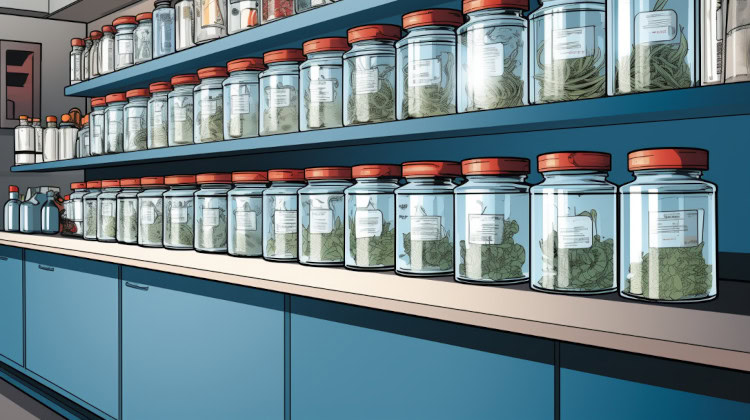In This Article
- Can Weed Help with PTSD?
- Which Terpenes Help With PTSD?
- How to Choose Strains for PTSD
- Understand the Role of Terpenes and Cannabinoids
- Look for a Certificate of Analysis (COA)
- Learn from Patient Reports
- Consult Resources and Experts
- The 5 Best Strains for PTSD
- Amnesia Haze
- Strawberry Cough
- Blueberry Pancakes
- Face Off OG
- Remedy
- References
Key Takeaways
- Cannabis may help with PTSD by improving mood and sleep quality.
- Patients report that strains high in limonene, caryophyllene, pinene, linalool, and myrcene help most.
- Popular strains for PTSD include: Amnesia Haze, Strawberry Cough, Blueberry Pancakes, and Remedy.
The vast range of strains available can make it confusing for new patients to choose between them. Depending on their symptoms, patients may try a strain and find it delivers polar opposite effects from those desired.
This often leads them to wonder what strains are best for their condition. For example, they may ask, what are the best weed strains for PTSD?
These cultivars could differ widely from those other patients might seek, like strains for inflammation. Several factors must be considered to find the best strains for PTSD.
Can Weed Help with PTSD?
Current clinical research is sparse and has mixed results on which cannabis strains are best for PTSD. Such mixed results further reinforce that relief depends significantly on the symptoms and the strain one chooses.
One study looked at cannabis as a potential solution to certain types of PTSD. However, results found that anti-inflammatory agents may reduce relief from PTSD symptoms, meaning some strains may not be as for post-traumatic stress disorder.1
Meanwhile, other research shows that cannabis can activate receptors in different parts of the brain and may potentially reduce anxiety, fear, and even unpleasant or intrusive memories. Cannabis may stimulate receptors at the front of our brains, which could reduce symptoms of depression, improve mood and memory, heighten sleep quality, and more. As a result, some researchers believe that cannabis might help relieve some symptoms of PTSD.2
A long-term study questioning if cannabis might provide a positive impact on PTSD looked at 150 participants across one year. Compared to the controls, high-THC cannabis consumers reported a more significant decrease in PTSD symptoms. Cannabis-consuming participants were 2.57 times more likely by the end to no longer meet the criteria for PTSD.3 Results like these are promising, urging researchers to perform clinical studies on a larger scale.
A survey of patients using CBG-dominant strains found 51.2% use cannabis for anxiety. However, the results may be largely dose-dependent, with higher doses actually inducing anxiety instead.4
Which Terpenes Help With PTSD?

Discovering which terpenes help with specific symptoms can help consumers narrow down the best strains for PTSD.
Limonene – Limonene has a low affinity for receptors but may have an entourage effect when paired with CBD, potentially boosting CBD’s anxiety-reducing, sedative-inducing, and anti-stress effects.5
Caryophyllene – Beta-caryophyllene is a common terpene in the cannabis plant. It has many effects, including anxiety and pain relief.5 As these are two common symptoms of stress disorders, caryophyllene might be an effective terpene in strains for PTSD.
Linalool – Linalool can activate the parasympathetic nervous system, which helps the body relax. Research suggests it has sedative properties. Consumers consistently report that the lavender-like aromas of linalool deliver relaxing, calming effects.6
Pinene – A clinical review examined pinene and linalool for therapeutic potential. The linalool-rich plants exerted anti-anxiety and antidepressant effects, while pinene helped improve sleep quality and several other benefits.7 Adequate sleep can help with mental health, so pinene may be often sought after when searching for the best strains for PTSD and other mental health conditions.
Myrcene – Myrcene is in many strains used for anxiety and sleep, as it’s well-known for its anti-anxiety and sedative effects.8 Patients with PTSD may seek symptom relief for both, so myrcene may fit as a suitable terpene in strains used for these symptoms.
How to Choose Strains for PTSD
The complexity of PTSD symptoms means that what works for one person might not work for another. When it comes to choosing the best strain for PTSD, patients need to consider several factors.
Understand the Role of Terpenes and Cannabinoids
It’s essential to focus on both terpenes and cannabinoids to find suitable strains for PTSD. Terpenes like limonene, caryophyllene, linalool, pinene, and myrcene have been highlighted for their potential benefits in managing PTSD symptoms.
Meanwhile, cannabinoids like THC, CBD, and CBG also play a crucial role. Patients might prefer THC-dominant and CBG-dominant strains for their potent therapeutic effects. However, strains with balanced THC and CBD may provide relief without intense intoxicating effects.
Look for a Certificate of Analysis (COA)
Always look for a certificate of analysis (COA) when purchasing cannabis. COAs provide detailed information on the strain's cannabinoid and terpene profile. This helps consumers find strains that have the desired compounds for managing PTSD.
Learn from Patient Reports
Other patients' experiences can be invaluable. Many PTSD patients report finding relief with specific strains. Conversely, different strains, terpenes, or types might exacerbate symptoms. Some patients find strains high in THC may increase anxiety. Starting with a lower dose and gradually increasing it can be beneficial.
Consult Resources and Experts
Leverage resources like NuggMD to understand how different cannabis compounds work together. Consult with healthcare providers, as they may be able to provide personalized guidance based on your medical history and symptom profile.
The 5 Best Strains for PTSD

It’s essential to stress that the best strains for PTSD for one patient may not work for another. Using a variety of factors, as well as trial and error, can help consumers pinpoint which strains for PTSD are most suitable for them.
Below are strains that patients report helping with various stress disorders.
Amnesia Haze
Amnesia Haze is a popular strain known for its euphoric and giggly-inducing effects. Its high limonene content could contribute to its mood-enhancing properties. Some note that it provides a sense of mental clarity and a sense of sociability. The cultivar helps some patients relieve stress and symptoms of anxiety and depression, and as a result, it may be a suitable option for PTSD patients.
Strawberry Cough
Strawberry Cough is a strain celebrated for reducing stress and anxiety. Its sweet, berry-like aroma and taste make it a favorite among patients. The strain is known for its calming effects, which could help reduce the intensity of PTSD symptoms while boosting mood and energy levels.
Blueberry Pancakes
Blueberry Pancakes has a sweet, fruity flavor profile. The strain is well-regarded for its relaxing and happy-inducing effects. It's become a suitable choice for some patients with PTSD-related anxiety and sleep disturbances. Blueberry Pancakes' high myrcene content may help induce a sense of calm and promote more restful sleep.
Face Off OG
Face Off OG is a strain that patients report relieves severe stress and anxiety symptoms, along with pain. The strain has a rich terpene profile of myrcene, limonene, and caryophyllene. That combination provides several patients with pain relief and relaxation. It might be a valuable option for PTSD patients with physical and mental discomfort.
Remedy
Remedy is a high-CBD strain with minimal intoxicating effects. It's most suitable for patients seeking relief without the high from THC. Known for its calming and therapeutic effects, Remedy may help reduce anxiety, stress, and inflammation. Its high CBD content, combined with a balanced terpene profile, makes it a gentle yet effective option for managing PTSD symptoms.
Experiment with different options to discover the best strain for PTSD symptoms for your unique needs. Consult a healthcare provider to determine the most suitable choice for your symptoms.
References
- Abizaid A, Merali Z, Anisman H. Cannabis: A potential efficacious intervention for PTSD or simply snake oil?. J Psychiatry Neurosci. 2019;44(2):75-78. doi:10.1503/jpn.190021 ↩︎
- Nacasch N, Avni C, Toren P. Medical cannabis for treatment-resistant combat PTSD. Frontiers in psychiatry. 2023;13. doi:https://doi.org/10.3389/fpsyt.2022.1014630 ↩︎
- Bonn-Miller MO, Brunstetter M, Simonian A, et al. The Long-Term, Prospective, Therapeutic Impact of Cannabis on Post-Traumatic Stress Disorder. Cannabis Cannabinoid Res. 2022;7(2):214-223. doi:10.1089/can.2020.0056 ↩︎
- Russo EB, Cuttler C, Cooper ZD, Stueber A, Whiteley VL, Sexton M. Survey of Patients Employing Cannabigerol-Predominant Cannabis Preparations: Perceived Medical Effects, Adverse Events, and Withdrawal Symptoms. Cannabis Cannabinoid Res. 2022;7(5):706-716. doi:10.1089/can.2021.0058 ↩︎
- Sommano SR, Chittasupho C, Ruksiriwanich W, Jantrawut P. The Cannabis Terpenes. Molecules. 2020;25(24):5792. doi:10.3390/molecules25245792 ↩︎
- Cui J, Li M, Wei Y, et al. Inhalation Aromatherapy via Brain-Targeted Nasal Delivery: Natural Volatiles or Essential Oils on Mood Disorders. Frontiers in Pharmacology. 2022;13. doi:https://doi.org/10.3389/fphar.2022.860043 ↩︎
- Weston-Green K, Clunas H, Jimenez Naranjo C. A Review of the Potential Use of Pinene and Linalool as Terpene-Based Medicines for Brain Health: Discovering Novel Therapeutics in the Flavours and Fragrances of Cannabis. Frontiers in Psychiatry. 2021;12. doi:https://doi.org/10.3389/fpsyt.2021.583211 ↩︎
- Surendran S, Qassadi F, Surendran G, Lilley D, Heinrich M. Myrcene—What Are the Potential Health Benefits of This Flavouring and Aroma Agent? Frontiers in Nutrition. 2021;8. doi:https://doi.org/10.3389/fnut.2021.699666 ↩︎
The information in this article and any included images or charts are for educational purposes only. This information is neither a substitute for, nor does it replace, professional legal advice or medical advice, diagnosis, or treatment. If you have any concerns or questions about laws, regulations, or your health, you should always consult with an attorney, physician or other licensed professional.




